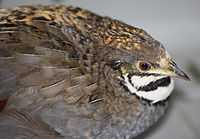King Quail
| King Quail | |
|---|---|
.jpg) | |
| Conservation status | |
| Scientific classification | |
| Kingdom: | Animalia |
| Phylum: | Chordata |
| Class: | Aves |
| Order: | Galliformes |
| Family: | Phasianidae |
| Subfamily: | Perdicinae |
| Genus: | Coturnix |
| Species: | C. chinensis |
| Binomial name | |
| Coturnix chinensis Linnaeus, 1766 | |
| Synonyms | |
|
Excalfactoria chinensis | |


The King Quail (Coturnix chinensis), also known as the Button Quail, Chinese Painted Quail, Chun-chi, Asian Blue Quail or Blue-breasted Quail, is in the same family as the pheasants Phasianidae of the order Galliformes, gallinaceous birds. These birds all have a distinctly larger breast-bone than other birds with more muscle surrounding the area. This is why they are hunted for their meat.
This species is the smallest "true quail" and is quite common in aviculture worldwide. In the wild they range from southeastern Asia to Oceania with 10 different subspecies.
Description
The male King Quail comes in many colors, including blue, brown, silver, maroon, dark brown & almost black. They have orange feet which are hard and able to withstand a continuous life on the ground like many other game birds.The female is similar to the male but cannot come in shades of blue. They can live up to 13 years in captivity but in the wild only 3-6. The eggs of King Quail are a light, creamy-brown colour and slightly pointed at the 'top'; roughly ovular in shape.
Taxonomy
Subspecies
There are nine recognized subspecies:
- C. c. chinensis - nominate - (Linnaeus, 1766) - India to Sri Lanka, Malaya, Indochina, southeastern China and Taiwan
- C. c. colletti (Mathews, 1912) - northern Australia
- C. c. lepida (Hartlaub, 1879) - Bismarck Archipelago
- C. c. lineata (Scopoli, 1786) - Philippines, Borneo, Lesser Sundas, Sulawesi and Sula Islands
- C. c. novaeguineae (Rand, 1941) - montane forests of New Guinea
- C. c. palmeri (Riley, 1919) - Sumatra and Java
- C. c. papuensis (Mayr and Rand, 1936) - southeastern New Guinea
- C. c. trinkutensis (Richmond, 1902) - Nicobar Blue-breasted Quail - Andaman and Nicobar Islands
- C. c. victoriae (Mathews, 1912) - eastern Australia
Reproduction

Clutch size varies anywhere from 5 to 13 eggs. Before incubation starts all the eggs composing the clutch will be laid. In captivity, if the female lays too many eggs, they should be taken, as after about 10 days they go cold and die. In captivity, the ideal number of eggs in a clutch is 6 to 8. The baby quails hatch after about 19 days and look a lot like chicken chicks but smaller.
Conservation status
Australia
King Quail are not listed as threatened on the Australian Environment Protection and Biodiversity Conservation Act 1999.
State of Victoria, Australia
- This species is listed as threatened on the Victorian Flora and Fauna Guarantee Act (1988).[2] Under this Act, an Action Statement for the recovery and future management of this species has not been prepared.[3]
- On the 2007 advisory list of threatened vertebrate fauna in Victoria, this species is listed as endangered.[4]
Aviculture
This quail has become very popular to keep and breed; numerous mutations have been developed. They are quite hardy once they have adjusted to their surroundings and will keep the bottom of an aviary spotless. The cost of purchasing and maintaining them is very little.
They are hyperactive breeders: a female will lay an egg a day if kept on the proper diet. She will make a soft "crowing" noise to attract a mate. These quail take only a small amount of time to feed and water and, in some cases, they have been known to become hand-tame.
They usually breed year round yielding a clutch of approximately 12 and sit from 18–23 days before chicks hatch. The hen bird will care for the chicks until around 4 weeks of age where they should be separated from parent birds into a separate aviary. It is recommended that you have at least 20² cm per bird.
Diet
In Aviculture, all birds should be fed a variety of seeds as well as a healthy range of fruit and vegetables. During breeding, hens should be fed calcium-rich food sources such as shell grit to prevent egg-bounding. Newly hatched chicks should be fed high protein chick crumb mixed in with a little water. Other sources of protein include mealworms and various bugs.
In the wild, the diet of King Quails consists of small bugs, seed and various grasses that are available at the time.
References
- ↑ BirdLife International (2013). "Coturnix chinensis". IUCN Red List of Threatened Species. Version 2013.2. International Union for Conservation of Nature. Retrieved 26 November 2013.
- ↑ Department of Sustainability and Environment, Victoria
- ↑ Department of Sustainability and Environment, Victoria
- ↑ Victorian Department of Sustainability and Environment (2007). Advisory List of Threatened Vertebrate Fauna in Victoria - 2007. East Melbourne, Victoria: Department of Sustainability and Environment. p. 15. ISBN 978-1-74208-039-0.
External links
| Wikimedia Commons has media related to Coturnix chinensis. |
| Wikispecies has information related to: Coturnix chinensis |
- BirdLife Species Factsheet
- ITIS Standard Report Page: Coturnix chinensis taxonomic details (includes subspecies)
